Phone:
(701)814-6992
Physical address:
6296 Donnelly Plaza
Ratkeville, Bahamas.


The dining room is more than just a space for meals; it represents the heart of the home—a place where families gather, friends connect, and memories are made. Thoughtful interior design can transform this essential area into a functional and inspiring environment.
With the rise of the Japandi style, which artfully merges Japanese minimalism with Scandinavian functionality, dining rooms can achieve a serene and stylish ambiance that caters to diverse personalities and lifestyles. This article explores various unique Japandi dining room concepts, each radiating charm and sophistication.
Throughout this article, we’ll delve into 20 distinctive Japandi dining room designs. Each concept showcases the beauty of simplicity and the elegance of natural materials, ensuring that there’s something for everyone.
From compact urban spaces to spacious suburban homes, these ideas will inspire you to create your own tranquil dining area that reflects your personal style.

Picture a dining room where a minimalist oak dining table with clean lines reigns supreme. The surrounding low-profile chairs, upholstered with woven textile seats, offer a touch of comfort while maintaining an uncluttered look.
The neutral color palette, a soothing blend of soft beige, warm grey, and muted sage green, invites a sense of calm. Large windows adorned with sheer linen curtains allow abundant natural light to filter in, enhancing the room’s airy atmosphere.
The concrete floor, with its subtle texture, adds an industrial edge while grounding the overall design. This space is a perfect embodiment of Japandi principles, where every element is thoughtfully selected to foster tranquility and connection.
The soft, diffused lighting highlights the natural textures of the materials, creating a warm and inviting environment for gatherings.

In a compact urban apartment, every square inch counts, and this Japandi dining room design rises to the occasion with a slim rectangular wooden dining table featuring built-in storage compartments. The Scandinavian-inspired chairs, with their rounded edges in light ash wood, offer both comfort and style.
This design not only maximizes functionality but also maintains a chic aesthetic that is essential in small spaces.
The minimalist floating shelves display ceramic serving pieces in muted earth tones, adding a touch of artistry without overwhelming the senses. Soft natural lighting from large windows enhances the openness of the space while creating a cozy nook for dining.
This design proves that elegance and functionality can coexist beautifully in urban living.

Imagine a dining room graced by the presence of a live-edge walnut dining table, perfectly positioned near floor-to-ceiling windows overlooking a serene zen garden. The minimalist chairs, featuring paper-thin cushions in soft grey linen, complement the table’s organic beauty.
This space embodies the tranquility of nature while fostering a sense of serenity and mindfulness.
A simple ceramic vase, home to a single branch, serves as an understated centerpiece, emphasizing the beauty of simplicity. The polished concrete floor reflects the natural light, creating soft shadows that dance across the room.
This design promotes a peaceful dining experience, inviting guests to slow down and appreciate the moment.

In a suburban home, a modular dining table with extendable sections in light oak creates a versatile space that can adapt to various occasions. This design allows for intimate family dinners or larger gatherings with ease.
The low-profile chairs, adorned with woven rattan backs, add an organic touch that enhances the room’s overall aesthetic.
The walls, painted in a soft textured warm grey, provide a subtle backdrop for minimal artwork featuring geometric line drawings, creating visual interest without cluttering the space. Natural light floods in from skylights, illuminating the room and highlighting its spatial efficiency.
This design not only looks beautiful but also functions seamlessly for everyday use.

This Japandi dining room design features a round dining table crafted from reclaimed teak wood, exuding warmth and character. Surrounding this centerpiece are chairs with clean geometric lines, providing a modern contrast to the table’s organic shape.
A soft textile runner in muted sage green ties the elements together, adding a touch of color and texture.
A floating wooden sideboard with integrated storage complements the table, offering a practical solution for dining essentials while maintaining a clean look. The large window, dressed in sheer white curtains, allows natural daylight to dance across the room, highlighting the wood grain textures and creating a cozy atmosphere.
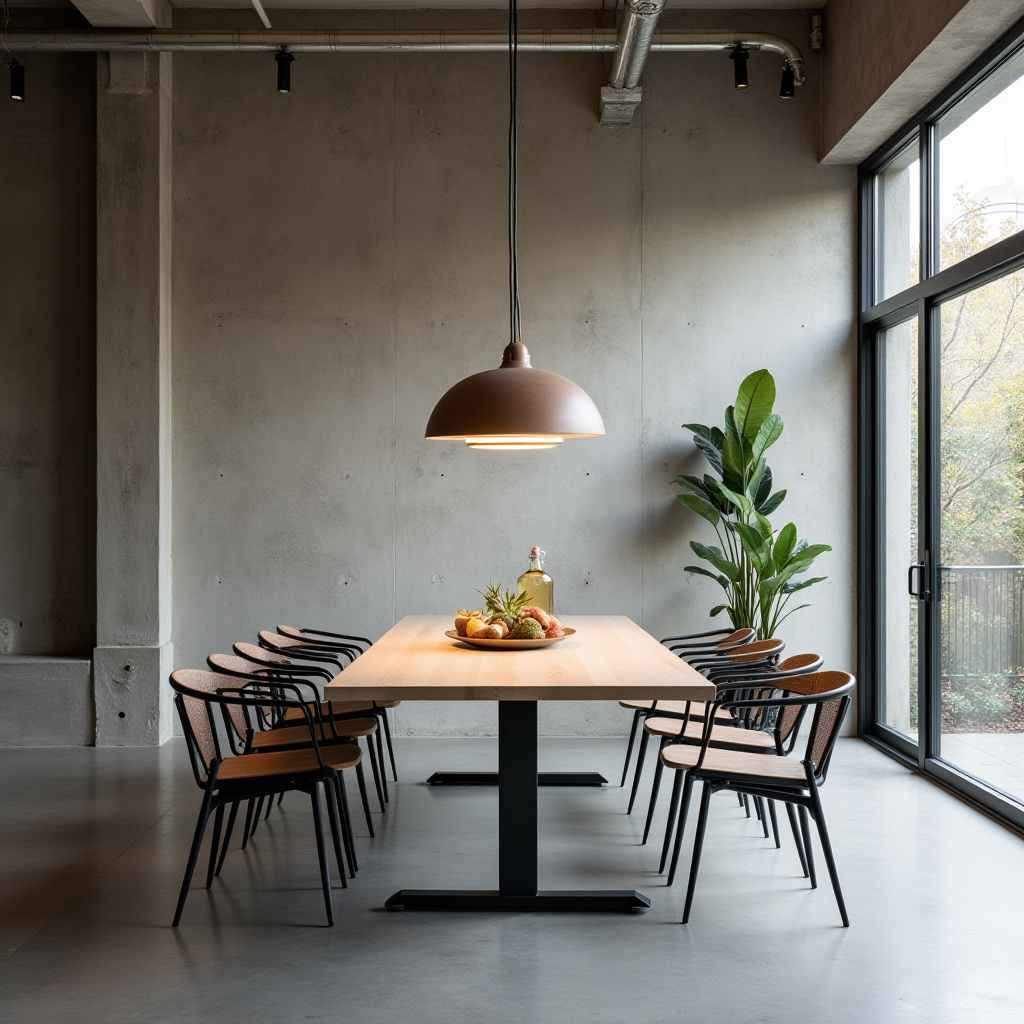
In a loft space, a long rectangular dining table with a blackened steel base and pale oak top creates a striking focal point. The minimalist chairs, with their slim metal frames, echo the industrial aesthetic while providing comfort.
A concrete accent wall with subtle texture adds depth and character to the space.
An oversized pendant lamp with a paper-like shade casts a warm glow over the table, enhancing the inviting atmosphere. This design captures the essence of Japandi style, blending industrial elements with organic materials to create a harmonious dining environment that encourages connection and creativity.

This Japandi dining room design showcases a compact fold-out dining table crafted from light birch wood, perfect for small spaces. Stackable chairs with minimal designs, upholstered in soft grey wool, provide comfort while maintaining flexibility.
A built-in bench with hidden storage along one wall offers additional seating without sacrificing space.
Soft natural lighting bathes the room, enhancing its airy feel. This design epitomizes functional minimalism, ensuring that every element serves a purpose while creating a stylish dining area that is both inviting and practical.

In an innovative Japandi dining room design, a floating dining table mounted to a concrete wall creates a unique and space-saving solution. Integrated bench seating complements the table, providing a cozy nook for dining.
Chairs made from pale ash wood with simple geometric forms complete the look, enhancing the minimalist aesthetic.
Ceramic wall art in neutral tones adds an artistic flair to the area without overwhelming the senses. A large window floods the room with soft, diffused light, making this dining space feel open and inviting.
This design embodies the essence of Japandi style, highlighting functionality and simplicity.

In a small apartment, a round pedestal table crafted from warm oak serves as the centerpiece of this Japandi dining room design. Chairs with curved backs upholstered in textured neutral fabric provide comfort while maintaining an elegant silhouette.
Minimal wall-mounted shelving in a matching wood tone adds functionality and style without cluttering the space.
Soft natural light from the window enhances the warmth of the wood tones, creating a welcoming atmosphere. This design effectively demonstrates how small spaces can be both stylish and functional, embodying the principles of Japandi living.
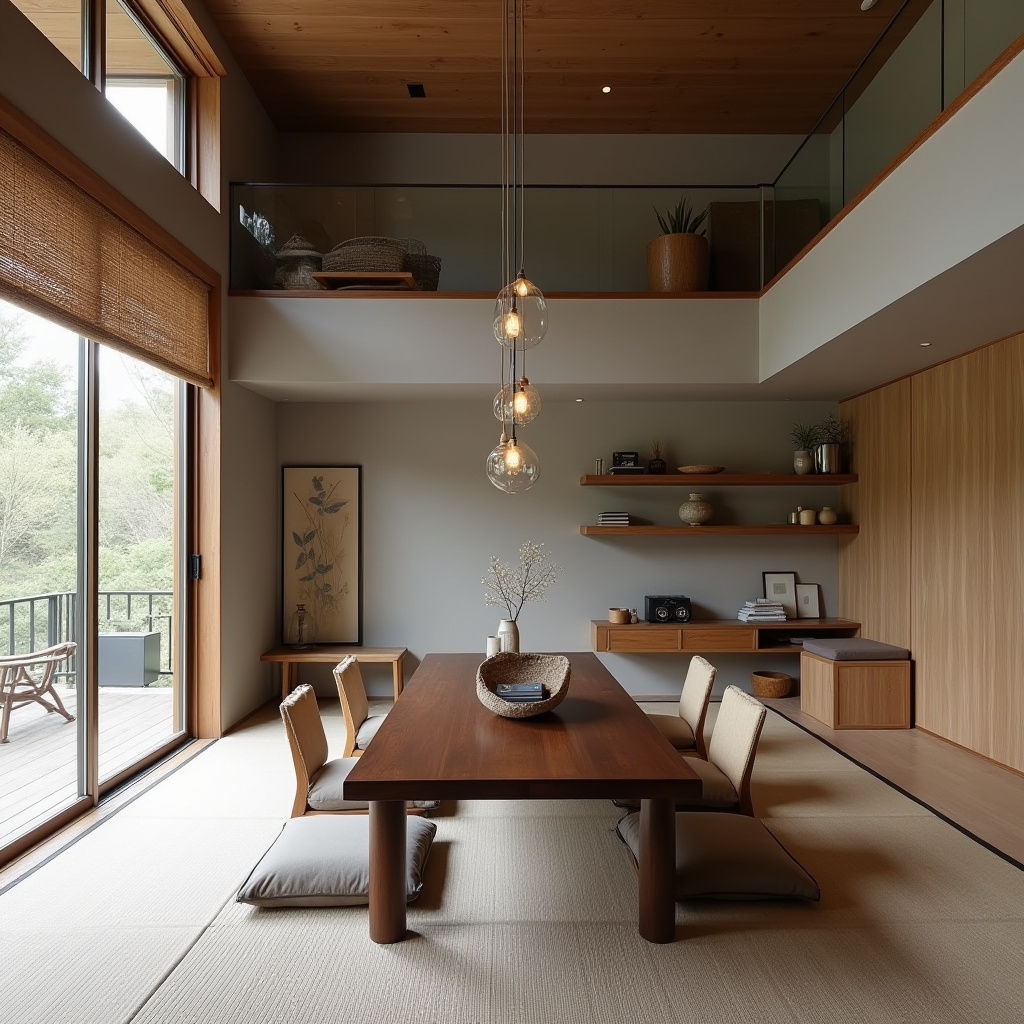
This Japandi dining room design features a split-level dining area, with a lower dining table in dark walnut surrounded by floor cushions for a casual dining experience. The upper level boasts minimalist chairs and floating wooden shelves, creating a dynamic and inviting space.
Soft grey walls provide a neutral backdrop, while a large window with a bamboo shade filters natural light beautifully.
The contrasting levels of the dining area not only add visual interest but also allow for varied dining experiences, from formal meals to relaxed gatherings. This design exemplifies the adaptability of Japandi style, catering to both comfort and elegance.
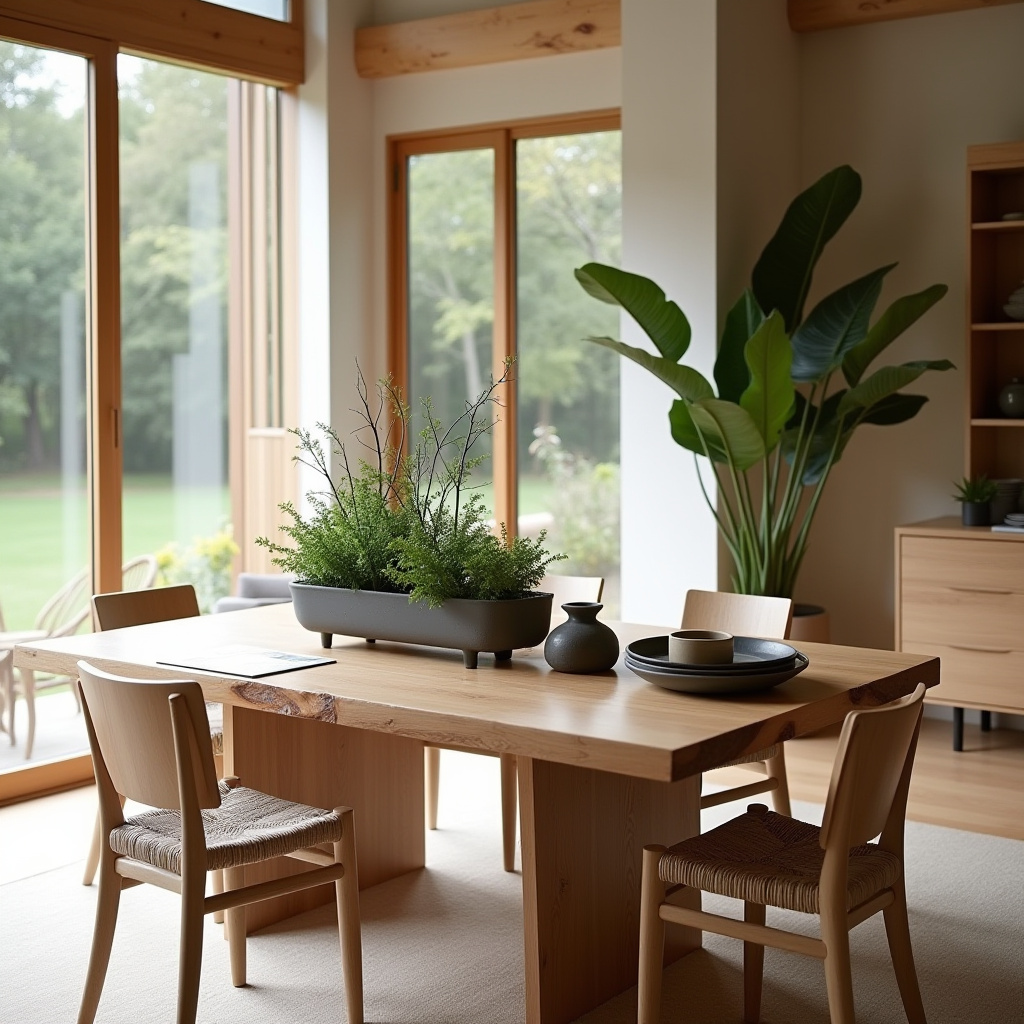
This Japandi dining room design features a dining table with an integrated planter box, showcasing a live edge oak surface that adds warmth and character. The chairs in pale ash wood, paired with woven textile seats, create a harmonious balance between comfort and style.
Ceramic serving pieces in muted earth tones complement the natural elements within the space.
Soft natural light streaming from multiple windows enhances the beauty of the materials, creating a serene dining environment that encourages connection with nature. This design highlights the importance of integrating greenery into living spaces, fostering a sense of calm and tranquility.
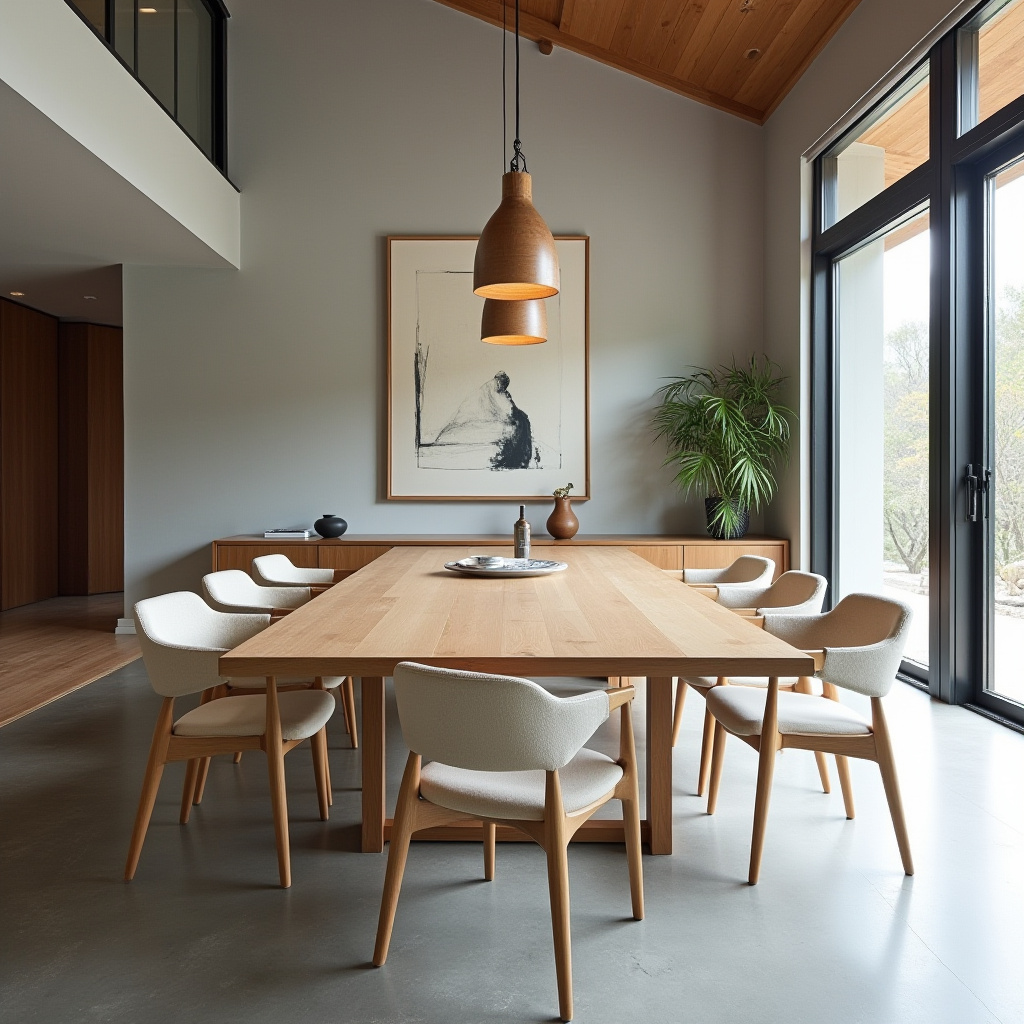
In this Japandi dining room design, high ceilings complement a long rectangular dining table crafted from pale oak. Slim chairs with paper-thin cushions provide comfort while maintaining a minimalist look.
The concrete floor, paired with soft grey walls adorned with minimal artwork, creates an understated yet elegant environment.
Large windows allow dramatic natural light to flood the room, accentuating the beauty of the materials and fostering a sense of openness. This design effectively utilizes vertical space, creating an airy atmosphere that is perfect for both intimate dinners and larger gatherings.

Showcasing a modular dining table with interchangeable sections, this Japandi dining room design is perfect for those who value adaptability. Chairs in light ash wood with geometric metal frames add a modern touch while providing comfort.
A soft textured wall in a warm neutral tone serves as a backdrop, creating a cohesive and inviting atmosphere.
A ceramic vase with a minimal branch arrangement adds a simple yet elegant centerpiece, while soft diffused lighting enhances the overall ambiance. This design embodies the principles of Japandi style, promoting functionality and simplicity in equal measure.
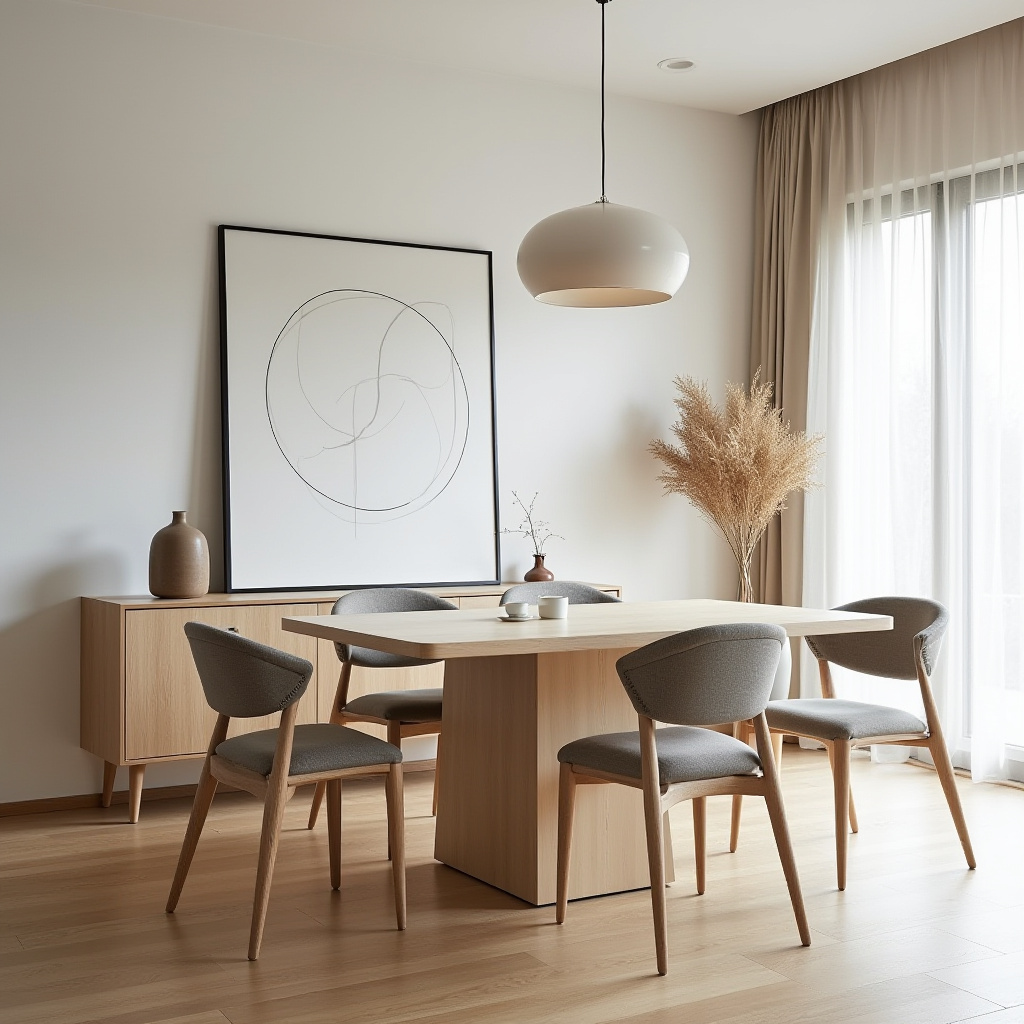
This Japandi dining room design features a dining table with hidden storage compartments crafted from light birch wood. The chairs, with their curved backs in pale grey fabric, provide comfort and style, enhancing the overall aesthetic.
Minimal wall art with geometric line drawings adds a touch of artistry without overwhelming the space.
A large window dressed in sheer curtains allows natural light to filter in, brightening the room while creating an inviting atmosphere. This design highlights the importance of storage solutions in maintaining a clutter-free dining area, ensuring that functionality does not compromise style.

In an open-plan living space, a dining table with a blackened steel base and pale oak top creates a striking focal point. The chairs, featuring slim metal frames, echo the industrial aesthetic while providing comfort.
A concrete accent wall adds depth to the design, while a soft textured rug underfoot enhances the warmth of the space.
An oversized window allows natural light to flood the area, creating a bright and inviting atmosphere. This design exemplifies the versatility of Japandi style, seamlessly integrating dining and living areas while maintaining a cohesive aesthetic.

This Japandi dining room design features a round dining table crafted from reclaimed teak wood, exuding warmth and character. Surrounding this centerpiece are low-profile chairs with woven rattan backs, providing comfort while maintaining a clean aesthetic.
Soft grey walls create a neutral backdrop for minimal ceramic artwork, enhancing the room’s tranquility.
A large window, adorned with a bamboo shade, allows natural light to filter in softly, creating a welcoming environment for dining. This design effectively combines sustainable materials with elegant aesthetics, embodying the principles of Japandi living.
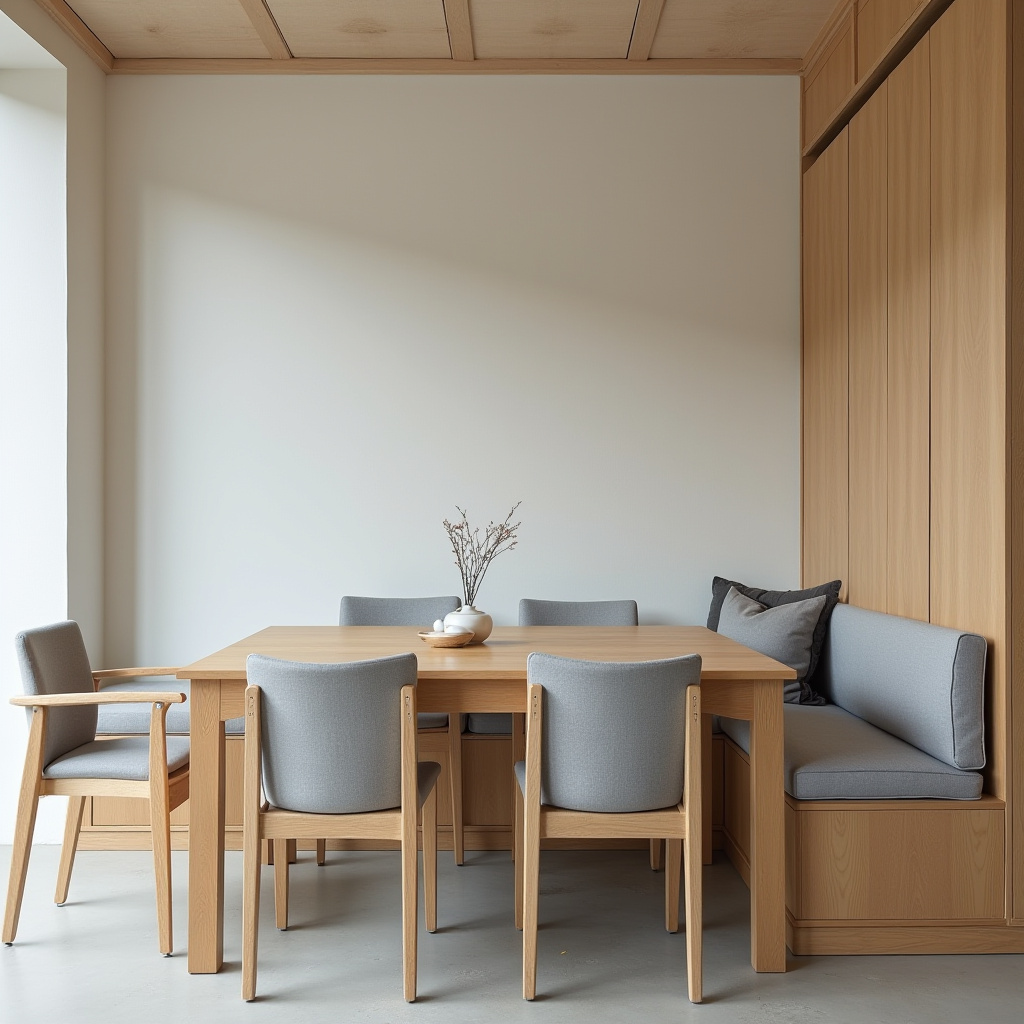
This Japandi dining room design features a fold-out dining table in light oak, perfect for those who appreciate practicality in small spaces. Stackable chairs in pale grey fabric provide comfort while maintaining flexibility, allowing for easy storage.
A built-in bench with hidden storage along one wall enhances functionality without compromising style.
The concrete floor, paired with soft neutral walls, creates a cohesive and inviting atmosphere. Professional interior design photography captures the essence of this space, showcasing how minimalism and functionality can coexist beautifully.

This Japandi dining room design showcases a dining table mounted to a concrete wall, featuring integrated bench seating that offers a unique and space-saving solution. Chairs crafted from ash wood with geometric forms provide additional seating while maintaining a minimalist aesthetic.
Ceramic wall art in muted tones enhances the design without overwhelming the senses.
A large window floods the room with soft natural light, creating an inviting atmosphere that encourages relaxation and connection. This design exemplifies the principles of Japandi style, balancing form and function while creating a serene dining experience.

This Japandi dining room design in a compact urban space features a round pedestal table in warm oak, serving as the perfect gathering point. Chairs with curved backs upholstered in textured neutral fabric provide comfort and style, enhancing the overall aesthetic.
Wall-mounted shelving in a matching wood tone adds functionality and visual cohesion without cluttering the space.
Soft window light filters into the room, enhancing the warmth of the wood tones and creating an inviting atmosphere. This design proves that even in small spaces, elegance and functionality can harmoniously coexist.

This Japandi dining room design features a split-level dining area, with a lower table in dark walnut surrounded by floor cushions for a casual dining experience. The upper level showcases minimalist chairs and floating shelves, creating a dynamic and inviting space.
Soft grey walls provide a neutral backdrop, while a bamboo window shade filters natural light beautifully.
The contrasting levels of the dining area not only add visual interest but also allow for varied dining experiences, from formal meals to relaxed gatherings. This design exemplifies the adaptability of Japandi style, catering to both comfort and elegance.
In conclusion, the Japandi dining room designs featured in this article showcase a perfect blend of Japanese minimalism and Scandinavian functionality. Each design highlights the importance of natural materials, neutral color palettes, and thoughtful spatial composition, creating inviting and serene dining environments.
As you explore these concepts, consider how you can incorporate elements of Japandi style into your own home. Whether you lean towards a compact urban design or a spacious suburban aesthetic, the principles of simplicity and functionality will guide you in creating a dining space that reflects your unique personality and lifestyle.
Embrace the art of Japandi design and transform your dining room into a harmonious retreat.